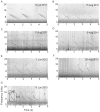Identification and characteristics of signature whistles in wild bottlenose dolphins (Tursiops truncatus) from Namibia
- PMID: 25203814
- PMCID: PMC4159226
- DOI: 10.1371/journal.pone.0106317
Identification and characteristics of signature whistles in wild bottlenose dolphins (Tursiops truncatus) from Namibia
Abstract
A signature whistle type is a learned, individually distinctive whistle type in a dolphin's acoustic repertoire that broadcasts the identity of the whistle owner. The acquisition and use of signature whistles indicates complex cognitive functioning that requires wider investigation in wild dolphin populations. Here we identify signature whistle types from a population of approximately 100 wild common bottlenose dolphins (Tursiops truncatus) inhabiting Walvis Bay, and describe signature whistle occurrence, acoustic parameters and temporal production. A catalogue of 43 repeatedly emitted whistle types (REWTs) was generated by analysing 79 hrs of acoustic recordings. From this, 28 signature whistle types were identified using a method based on the temporal patterns in whistle sequences. A visual classification task conducted by 5 naïve judges showed high levels of agreement in classification of whistles (Fleiss-Kappa statistic, κ = 0.848, Z = 55.3, P<0.001) and supported our categorisation. Signature whistle structure remained stable over time and location, with most types (82%) recorded in 2 or more years, and 4 identified at Walvis Bay and a second field site approximately 450 km away. Whistle acoustic parameters were consistent with those of signature whistles documented in Sarasota Bay (Florida, USA). We provide evidence of possible two-voice signature whistle production by a common bottlenose dolphin. Although signature whistle types have potential use as a marker for studying individual habitat use, we only identified approximately 28% of those from the Walvis Bay population, despite considerable recording effort. We found that signature whistle type diversity was higher in larger dolphin groups and groups with calves present. This is the first study describing signature whistles in a wild free-ranging T. truncatus population inhabiting African waters and it provides a baseline on which more in depth behavioural studies can be based.
Conflict of interest statement
Figures



References
-
- Cortopassi KA, Bradbury JW (2006) Contact call diversity in wild orange-fronted parakeet pairs, Aratinga canicularis . Animal Behaviour 71: 1141–1154.
-
- Wanker R, Apcin J, Jennerjahn B, Waibel B (1998) Discrimination of different social companions in spectacled parrotlets (Forpus conspicillatus): evidence for individual vocal recognition. Behavioral Ecology And Sociobiology 43: 197–202.
-
- Poole JH, Payne K, Langbauer WRJ, Moss CJ (1988) The social contexts of some very low frequency calls of African elephants. Behavioral Ecology and Sociobiology 22 385–392.
-
- Illmann G, Schrader L, Spinka M, Sustr P (2002) Acoustical mother-offspring recognition in pigs (Sus scrofa domestica). Behaviour 139: 487–505.
-
- Janik VM, Sayigh LS (2013) Communication in bottlenose dolphins: 50 years of signature whistle research. Journal of Comparative Physiology A: Neuroethology, Sensory, Neural, and Behavioral Physiology 199: 479–489. - PubMed
Publication types
MeSH terms
LinkOut - more resources
Full Text Sources
Other Literature Sources

